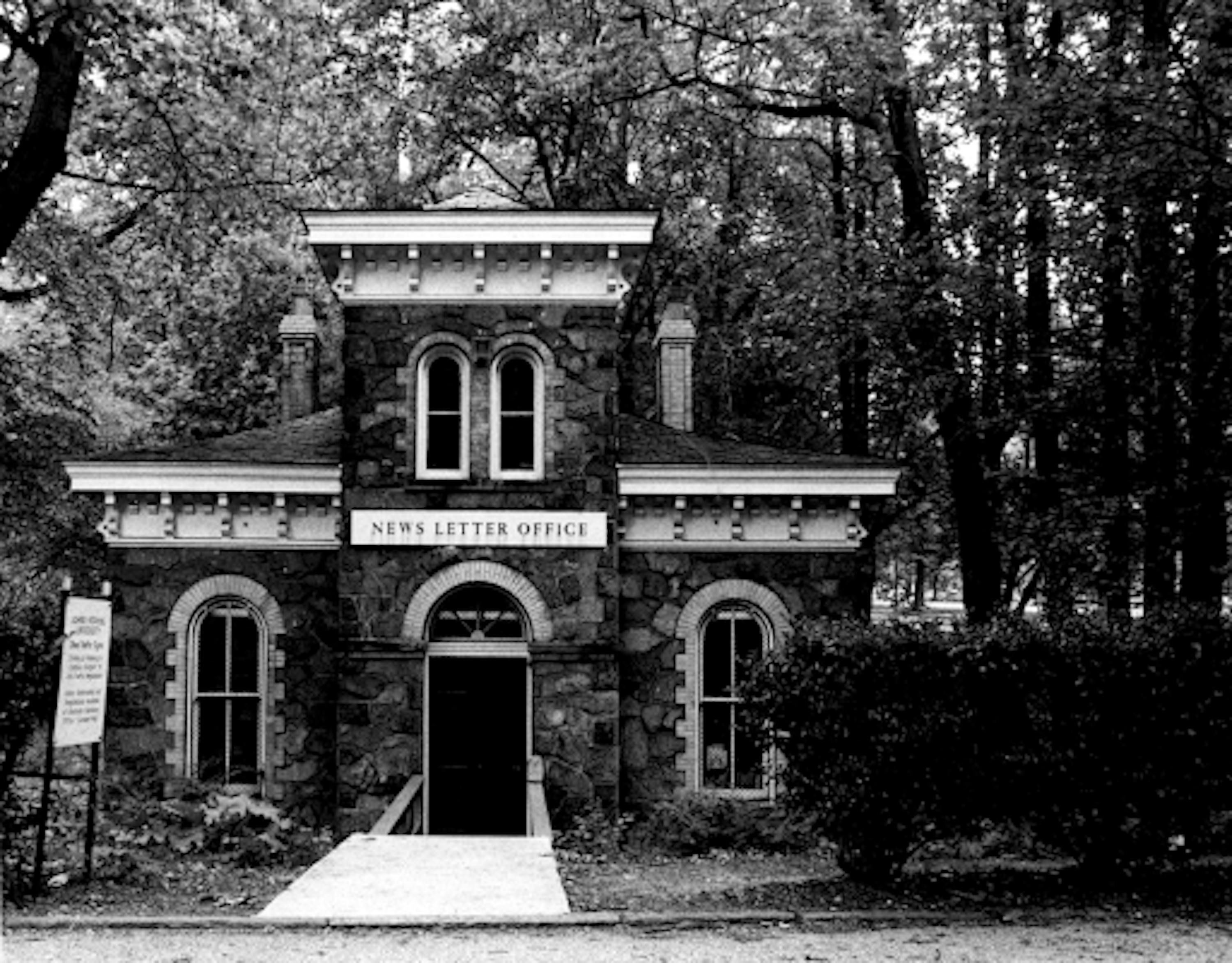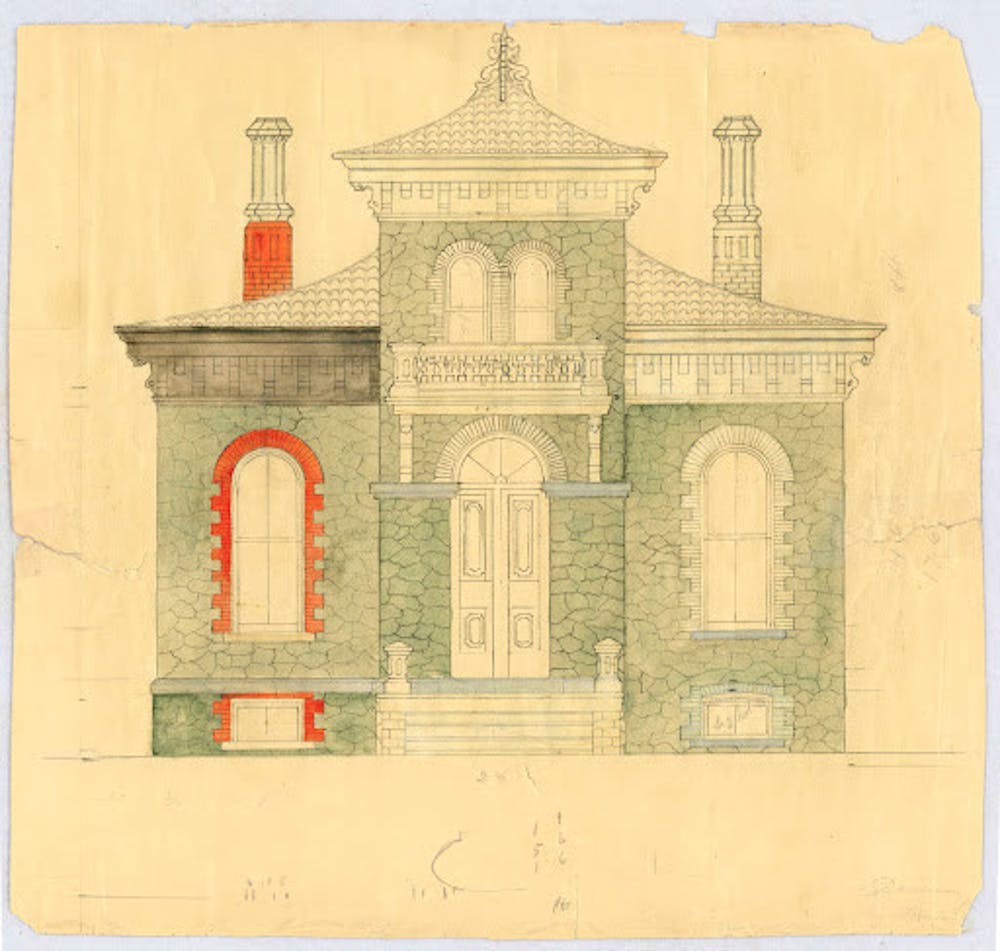Bluish-gray stone walls. Yellow accents around arched windows. A slippery, rundown wooden bridge leads to a front door with white paint peeling off it. And mounted over the door, a plaque which reads “News Letter Office.”
It’s an interesting little structure, says Jim Stimpert, senior reference archivist for the University Archives.
“I’ve wondered how many people going up Charles Street, sitting at the red light on Art Museum Drive, have looked over and said, ‘What the heck is that little thing doing over there?’” he said.
The structure in question? The Gatehouse. It is either unknown to students or recognized as The News-Letter’s home. But as for why it’s there, on the southern corner of campus and mostly unacknowledged, well, that answer has changed over the 145 years since its construction.
It is unknown where The News-Letter staff operated in its earliest days. At a point in the 1900s, the paper’s offices were in a small basement room on the north side of Levering Hall, according to University Vice President and Secretary Emeritus Ross Jones, who started working on The News-Letter in the fall of 1949. News-Letter editors worked next door to the campus barbershop. The room was demolished in the 1970s, and the Glass Pavilion now stands in its place.
The News-Letter eventually moved to the Barn (now known as Merrick Barn), another structure from the Homewood Estate days. Over the years, different groups occupied the space, including another barbershop and the YMCA office. The honors commission, yearbook committee and the Barnstormers used the Barn as well.
In an email to The News-Letter, former Business Manager Arthur Cleveland described the paper’s previous home.
“The lower barn space in the early '60s was divided into the editorial area, with the typewriters, desks and file cabinets of a typical publication,” Cleveland wrote. “In the back hallway was the Business Mgr. desk, and beyond the dark room where almost all the pictures got developed and printed.”
A few minutes’ walk away, the Gatehouse had gone through a number of occupants. Its location and size meant that no one was quite sure what to do with it.

COURTESY OF CLAYTON BLICK
The Gatehouse in the early 1970s.
Before Hopkins was established, the area which is now the campus was known as Homewood Estate. Originally home to the Carroll family, it was sold to merchant Samuel Wyman in 1839. The Wymans expanded upon the property, adding a new manor called Wyman Villa for a family residence. The Gatehouse, then known as the Homewood Lodge, was built at the entrance of the estate. While the original Homewood buildings (including Homewood House, which is now a museum) were built in a Federal architecture style, Wyman’s new structures had an Italianate look.
According to Stimpert, the Gatehouse likely lived up to its namesake.
“In earlier times, there may have actually been a gate across the road entering the estate property. So, the gatekeeper might have been the one who would decide who shall pass through this gate and who is not allowed onto the property,” Stimpert said. “In later years, it more or less became a cottage where the gardener or caretaker could live and be close, to have his own lodging and be close to the campus without actually living in the house itself.”
After the University acquired the property, the Gatehouse was used for odds and ends. According to the record “The Homewood Campus: Its Buildings, Monuments and Sculpture,” the Department of Gas Engineering used the space in the 1920s and early 1930s. The Camera Club may have used it after a renovation, and chemical engineering labs were taught in the building in 1939. At least two graduate students even lived in the attic.
“It was the smallest building. It was really too small to serve much of an academic purpose,” Stimpert said. “But they didn’t want to knock it down — apparently it was in at least sound condition, unlike the Wyman Villa, which was knocked down. They decided, ‘Well, let’s leave it standing and we’ll find something, some purpose for it.’”
In the fall of 1965, a purpose was found: serving as The News-Letter’s new home.
It was former Editor-in-Chief Caleb Deschanel’s plan to move to the Gatehouse. The building was empty, and The News-Letter’s staff was eager to move from the Barn.
“We always would walk by there and go, you know, why isn't this being utilized for something?” Deschanel said.
Deschanel’s Co-Editor-in-Chief Jim Freedman noted that the editors mostly lived on 29th Street, which was closer to the Gatehouse than the Barn. Another bonus: Hopkins leadership wouldn’t have to deal with the paper as often if they moved to a less central location.
“I think the administration were very pleased to see us get farther away from the center of campus,” Freedman said. “They were happy to see us peripheralized... It was very funny, but it was ideal.”
With each week’s publication, Deschanel and Freedman were often called to speak with University President Milton S. Eisenhower and other administrators, who were upset when they published content that reflected negatively on Hopkins. Plus, the “work hard, play hard” attitude of The News-Letter’s staff would be as removed as possible from other students.
“That’s probably why there was so little red tape,” Deschanel said. “We would no longer be negatively influencing the people in the Barnstormers or any of the other areas on campus.”
Cleveland, Deschanel and Freedman all recounted staff members arranging layout in the offices, whether it was the Barn or the Gatehouse. Though the techniques have changed, this was the primary use of the Gatehouse until print publication ceased in March 2020.

COURTESY OF KATY WILNER
In 2021, the Gatehouse exterior still strongly resembles its original design.
Current staff members consider the Gatehouse today to be both comfortable and questionable. The main room features two squashy couches (one bright red, a recent donation from a former Copy and News & Feature Editor, the other light blue with unknown origins). The walls are covered with two large whiteboards and a dozen staff-awarded Section of the Week certificates.
Two smaller rooms, known as the side rooms, house years-old Mac computers. Though they have mostly been shut off for the last year, in pre-pandemic times they would all be used on Wednesday nights as editors designed their print pages on Adobe InDesign. All along the walls are funny quotes from those long publication nights, when the hours dragged on and collective brain power decreased.
Less frequently used is the basement, which has a conference area and a bathroom. It is also home to the occasional centipede or fly infestation. The least popular space is the attic, which can only be accessed by ladder.
Though the interior may have changed from the original — Deschanel and Freedman did not start the quote tradition, and they are unsure who did — the building still carries the same attitude of working hard and making a difference.
“It looked to us like it was a wonderful place,” Freedman said.
For the team who works there today, it’s remembered for being the home of sleepless nights and quotes on the wall. But for those who drive by, it’s simply an odd structure on the side of Homewood Campus.

















